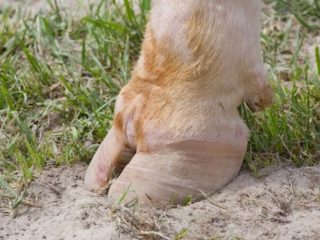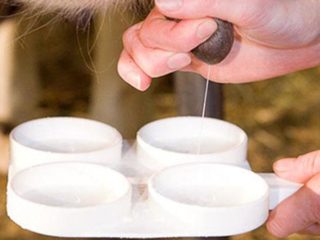Content
Originally Russian, obtained by folk selection, the Kholmogory breed of cows was bred back in the 16th century in the area of the Northern Dvina River. Bred in the north of Russia, the breed is ideally adapted to the climatic conditions of the Russian north. Since the 18th century, attempts have been made to infuse the Kholmogory breed with the blood of East Friesian cattle, but Holsteinization was not successful. Due to their effeminacy, Dutch cattle were unable to have a significant impact on the Kholmogory breed. The Kholmogorkas even had a black and piebald color even before the Holsteins were brought in to them. The original Kholmogory cows had three color options: black. White, and black and piebald.
The last attempt to add Holstein blood was made in the late 1930s. The goal was to increase the milk yield and appearance of the Kholmogory cow. The result was a sharp drop in milk fat content. And the experiment was stopped. But since 1980, Holstein bulls began to be used again on Kholmogory dams. As a result of crossing and breeding of crossbreeds in different regions of Russia, three intra-breed types were identified and approved in the breed:
- “Central”: the central part of the Russian Federation;
- "Northern": Arkhangelsk region;
- "Pechorsky": Komi Republic.
The Kholmogory breed of cows is one of the most common in Russia.It is bred in 24 regions of the country. The number of Kholmogory cows is almost 9% of the total number of dairy cattle bred in Russia.
Description of the breed
Height at the withers is 130 cm. The constitution is strong. The head is medium in size with a narrow muzzle. The neck is long and thin. The body is long, the chest is narrow and shallow. Chest circumference is about 196 cm. The dewlap is poorly developed. The sacrum is wide. The foot placement is correct. The udder is cup-shaped, medium in size. All lobes are evenly developed.
The color is mainly black and piebald, but black and red piebald are also found. Red is very rare. Considering that the gene for red color is present in the breed, but is recessive, the birth of red calves is quite justified.
Defects include a “goat” udder and a third pair of nipples.
The advantages of the breed are their resistance to diseases characteristic of cold climates, as well as higher resistance to leukemia.
Kholmogorki are characterized by early ripening. Their first calving usually occurs at 30 months.
Cows that give birth to twins are rejected from further breeding.
Productive characteristics
With good care and proper feeding, the average Kholmogory cow is capable of producing 3.5 - 4 tons of milk with a fat content of 3.6 - 3.7% during the lactation period. Elite breeding stock from farms that continue to work to improve the productivity of Kholmogory cows has a higher milk yield. The table shows an increase in milk yield for the average livestock and in breeding farms. 5
Breeders strive primarily to increase the fat content of milk in this breed of cattle.
Work is also underway on the meat productivity of Kholmogory cattle. In general, Kholmogory has a good slaughter yield of meat, so it is profitable to leave Kholmogory bulls for fattening and slaughter.
The photo shows an adult Kholmogory bull.
The weight of an adult Kholmogorka is 450 - 500 kg, a bull 820 - 950 kg. In an elite breeding herd, the average weight of individuals may be higher. Adult bulls of the Kholmogory breed are well muscled, and bulls quickly gain weight. Kholmogory heifers are born weighing 32 - 35 kg, bull calves weigh 37 - 39 kg at birth. With a well-designed diet, calves at 6 months can already gain weight of 160 - 200 kg. Heifers usually weigh up to 180 kg, bulls from 180 kg. By one year, calves gain 280-300 kg. The slaughter yield of meat is 50 – 54%.
In villages, it is practiced to slaughter six-month-old calves that have been fattened on free summer grass. From the point of view of a private owner, this is the most profitable way to obtain meat. Keeping a bull on purchased feed in winter is less profitable. On farms, bull calves are usually sent to slaughter at 1–1.5 years of age. Castrating a bull over one and a half years old is unprofitable and very dangerous for the veterinarian. Typically, bull calves destined for slaughter are castrated at 6 months. Therefore, the information found about fattening Kholmogory bulls after one and a half years and daily weight gain of 1 kg is unlikely to correspond to reality. The only exception is fattening a culled sire before slaughter.
Most likely, Kholmogory cattle are suffering from the heat.Another disadvantage, from the point of view of the southern regions, is the “habit” of Kholmogory cows to the abundance of grass in the summer. Contrary to cliches, in the summer the north is very rich in herbs, often growing as tall as a person. There is a poor supply of cultivated cereals there, so the peculiarity of the hills is the ability to fatten up the body and produce good milk yield on feed that is meager in terms of nutrition, that is, grass and hay. At the same time, a cow’s daily need for grass is 100 kg.
Reviews from owners of Kholmogory cows
Conclusion
The Kholmogory breed of cattle, with all its unpretentiousness and resistance to diseases, is not very suitable for breeding in such southern regions of Russia as Stavropol, Krasnodar Territory or Crimea. But Kholmogory cattle are very common and loved in the northern and central regions, where they show maximum productivity.













